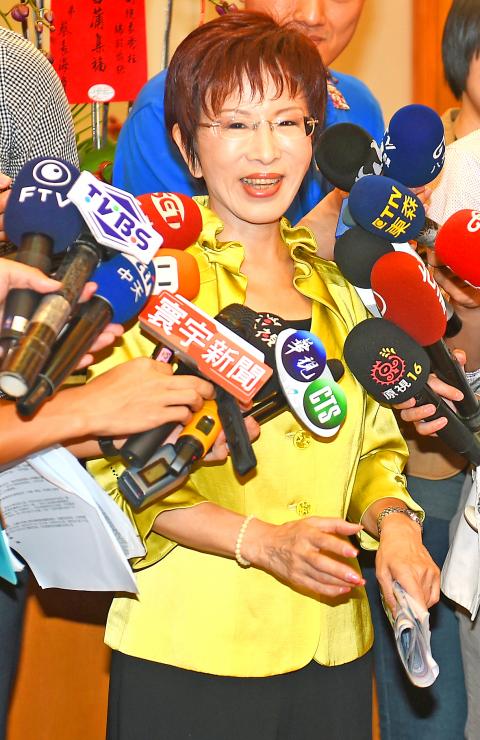The Republic of China (ROC) Constitution allows no possibility of Taiwanese independence, Chinese Nationalist Party (KMT) presidential hopeful Hung Hsiu-chu (洪秀柱) said yesterday, when asked whether she would take a more radical approach to pushing for cross-strait unification.
“You can look at the ROC Constitution. Does it allow for Taiwanese independence?” the deputy legislative speaker told reporters, when she was asked for her views on media commentaries that said she would accelerate the process of unification if she wins the presidential election in January.
Cross-strait policy under any administration must respect the Constitution, Hung said, adding that even Democratic Progressive Party (DPP) Chairperson and presidential candidate Tsai Ing-wen (蔡英文) said in a speech at the Center for Strategic and International Studies in Washington earlier this month that she would handle cross-strait relations in accordance with the ROC Constitution.

Photo: Chang Chia-ming, Taipei Times
The beginning of the Additional Article of the Constitution states that any articles that are added to or amended in the Constitution are to “meet the requisites of the nation prior to national unification,” Hung said.
That clearly shows the ROC Constitution is based on the “one China” principle, she added.
Hung said that what worries Taiwanese is the prospect of unification taking place on China’s terms, because China wishes to apply its “one country, two systems” formula in the unification of Taiwan, while Taiwan wants to see a unified China characterized by freedom, democracy and the rule of law.
Hung again pledged to sign a peace treaty with China if she is elected president, saying the idea had been proposed in the past by former presidents Lee Teng-hui (李登輝) and Chen Shui-bian (陳水扁) as well as President Ma Ying-jeou (馬英九). She added that Tsai helped formulate Chen’s proposal when she served as Mainland Affairs Council minister.
“I did not invent the idea. They did not follow through with it, probably because it aroused some suspicion among the public, but if the idea is in the interests of Taiwan, we should make it clear to the public,” Hung said.
She added that signing a cross-strait peace treaty is consistent with the so-called “1992 consensus,” referring to a tacit understanding between the KMT and the Chinese government that both sides of the Taiwan Strait acknowledge there is “one China,” with each side having its own interpretation of what “China” means.
“There is no difference between the two. What we need to think about is whether we should take a step further into the ‘deep-water zone’ beyond the ‘1992 consensus’ and whether we should try to make a breakthrough in cross-strait relations or whether we would rather stay where we are now,” Hung said.

US climber Alex Honnold is to attempt to scale Taipei 101 without a rope and harness in a live Netflix special on Jan. 24, the streaming platform announced on Wednesday. Accounting for the time difference, the two-hour broadcast of Honnold’s climb, called Skyscraper Live, is to air on Jan. 23 in the US, Netflix said in a statement. Honnold, 40, was the first person ever to free solo climb the 900m El Capitan rock formation in Yosemite National Park — a feat that was recorded and later made into the 2018 documentary film Free Solo. Netflix previewed Skyscraper Live in October, after videos

Starting on Jan. 1, YouBike riders must have insurance to use the service, and a six-month trial of NT$5 coupons under certain conditions would be implemented to balance bike shortages, a joint statement from transportation departments across Taipei, New Taipei City and Taoyuan announced yesterday. The rental bike system operator said that coupons would be offered to riders to rent bikes from full stations, for riders who take out an electric-assisted bike from a full station, and for riders who return a bike to an empty station. All riders with YouBike accounts are automatically eligible for the program, and each membership account

NUMBERS IMBALANCE: More than 4 million Taiwanese have visited China this year, while only about half a million Chinese have visited here Beijing has yet to respond to Taiwan’s requests for negotiation over matters related to the recovery of cross-strait tourism, the Tourism Administration said yesterday. Taiwan’s tourism authority issued the statement after Chinese-language daily the China Times reported yesterday that the government’s policy of banning group tours to China does not stop Taiwanese from visiting the country. As of October, more than 4.2 million had traveled to China this year, exceeding last year. Beijing estimated the number of Taiwanese tourists in China could reach 4.5 million this year. By contrast, only 500,000 Chinese tourists are expected in Taiwan, the report said. The report

Temperatures are forecast to drop steadily as a continental cold air mass moves across Taiwan, with some areas also likely to see heavy rainfall, the Central Weather Administration (CWA) said. From today through early tomorrow, a cold air mass would keep temperatures low across central and northern Taiwan, and the eastern half of Taiwan proper, with isolated brief showers forecast along Keelung’s north coast, Taipei and New Taipei City’s mountainous areas and eastern Taiwan, it said. Lows of 11°C to 15°C are forecast in central and northern Taiwan, Yilan County, and the outlying Kinmen and Lienchiang (Matsu) counties, and 14°C to 17°C